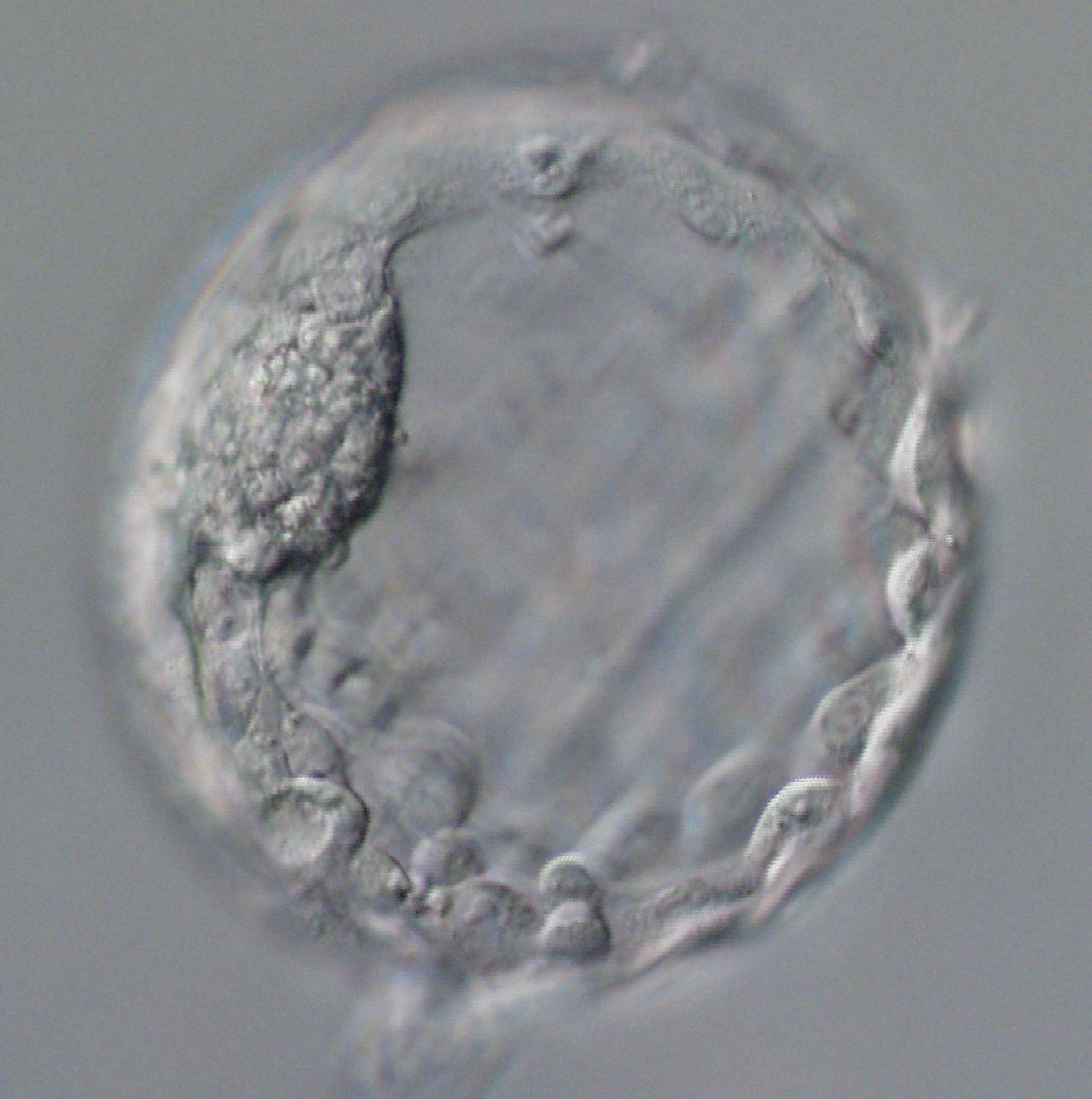A few hours after a human egg is fertilized, the process of cell division begins with the duplication of the genome. It is one of the most stressful times of development.
During cell division, the entire genome-46 chromosomes containing more than 3 billion base pairs of DNA-must be duplicated.
"Duplicating the genome so each new cell has a copy is a huge challenge for the early embryo," says Columbia stem cell scientist Dieter Egli, who discovered a few years ago how surprisingly treacherous this process could be. "We saw in our studies that embryos not only incur frequent problems with replication, they were also poor at solving the problems."
When embryos can't solve their replication problems, they start making mistakes. Entire chromosomes can be misplaced. The result of this genomic instability is often the demise of the embryo.
Human embryos seem to have a particularly hard time coping with replication stress.

A human embryo six days after fertilization. Most human embryos made with IVF stop their development in the first few days. Image provided by Dieter Egli / Columbia University Irving Medical Center.
"Most human embryos made with IVF stop their development in the first few days, and we don't see that with mice," Egli says. "We know that there is replication stress in mice. They just handle it better.
"The questions now are what causes replication stress, how do embryos handle it, and what can we do to prevent genetic and developmental abnormalities during IVF to create more efficient, safer, and more affordable fertility treatments."
Those questions are now driving a new collaboration between Egli and Columbia cancer researcher Juan Manuel Schvartzman, with support from the W. M. Keck Foundation.
Lessons from cancer may help Egli and Schvartzman better understand the stress early human embryos are under and how they try to cope. "Both types of cells experience replication stress, and it's actually very surprising how cancer cells resemble early embryonic cells," Schvartzman says.
Similarities between cancer and embryonic cells
That human embryos share the same genomic instability and chaos as cancer cells has puzzled researchers for decades: Why would embryonic cells behave like tumor cells when genome integrity is the sine qua non of normal development?
Schvartzman studies the metabolism of cancer cells and has learned that certain metabolites cause replication stress in cancer cells, which thrive on the genomic damage the stress triggers. High concentrations of these same metabolites have also been found in embryonic cells, which don't thrive on the damage."It's actually very surprising how cancer cells resemble early embryonic cells."
"The idea we're testing here is that replication stress occurs as a result of the metabolic changes present in the embryo. We have ways of changing that metabolic environment and the hope is that these interventions might improve the success rate of fertility treatment."
Egli and Schvartzman's studies will rely on human embryos, but because the NIH does not fund such research, the new funding from the Keck Foundation is critical. The ban on NIH funding for research with early human embryos, Egli adds, has really hurt our understanding of our own development.

DNA damage. In a 3-day-old human embryo, green spots mark breaks in DNA that occur from replication stress, a process that also occurs in cancer cells. Image provided by Dieter Egli / Columbia University Irving Medical Center.
"We know more about the early development of the fly or worm than we know about humans, and one reason is ethical of course," Egli says. "Having this substantial funding gives us an extraordinary opportunity to drive the science forward dramatically. We are very grateful to the foundation."
Guidelines allow researchers to culture human embryos until day 14, but Egli and Schvartzman's study will focus on just the first few days after fertilization.
The benefits from the research are likely to go beyond improving fertility treatments.
"Viable genetic change happening in this stressful window could affect the health of the fetus, the pregnancy, the newborn, and the adult," Egli says.
"We really don't know very much about how this window of genomic instability in early development affects our health as adults, and that's very important to understand. It could very well help us understand health and disease in many different areas."
References
Additional information
Top image of early human embryos from Zeiss Microscopy CC BY-SA 2.0.
Dieter Egli, PhD, is associate professor of developmental cell biology at Columbia University Vagelos College of Physicians and Surgeons, with appointments in the Departments of Pediatrics and Obstetrics & Gynecology, the Naomi Berrie Diabetes Center, and the Columbia Stem Cell Initiative.
Juan-Manuel Schvartzman, MD, PhD, is assistant professor of medicine at Columbia University Vagelos College of Physicians and Surgeons in the Division of Hematology & Oncology and the Herbert Irving Comprehensive Cancer Center. He is a medical oncologist at ColumbiaDoctors where he specialized in treating patients with gastrointestinal cancers.
The W. M. Keck Foundation was established in 1954 in Los Angeles by William Myron Keck, founder of The Superior Oil Company. One of the nation's largest philanthropic organizations, the W. M. Keck Foundation supports outstanding science, engineering and medical research. The Foundation also supports undergraduate education and maintains a program within Southern California to support arts and culture, education, health and community service projects.






